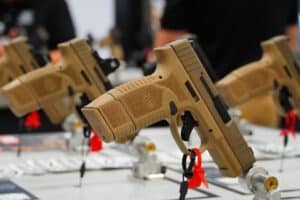In addition to considering whether the federal gun ban for persons under domestic violence restraining orders is constitutional, the Supreme Court pondered how its new gun test applies to all categories of disarmament on Tuesday.
The High Court heard oral arguments in the case U.S. v. Rahimi Tuesday morning. Amidst a series of questions on the history of domestic violence in the country and the specific terms of the federal gun ban for those under restraining orders, the discussion kept returning to the question of what type of established conduct voids a person’s Second Amendment protections.
“Could I just say that it’s ‘dangerousness?'” Justice Amy Coney Barrett remarked during a line of questioning with the U.S. Solicitor General. “Let’s say that I agree with you that when you look back at surety laws and affray laws etc… that it shows that the legislature can make judgments to disarm people consistent with the Second Amendment based on dangerousness. Why can’t I just say that?”
The line of inquiry raised by Justice Barrett, one of several similarly explored by the other Justices, highlights the likelihood that the Court could clarify that its Bruen test allows for disarmament after a legal finding of “dangerousness” or some other criteria. Whatever standard they choose will have major implications not just for Rahimi but other disputes over which types of people can be disarmed.
Indeed, both the Justices and the Government seemed keenly aware of other potential disarmament cases looming over the Rahimi proceeding, including the issue of gun rights for non-violent felons.
“You’re trying to save the Range issue,” Justice Barrett said, referring to a Third Circuit decision striking down the federal gun ban for a particular non-violent felon in response to the Government’s request to establish “law-abiding” and dangerousness as two separate criteria for disarmament.
The Government has asked the Supreme Court to review that case as well this term.
While the notion of establishing a test that determines who can be barred from gun ownership for certain conduct featured prominently throughout the argument, opinions seemed to differ on which specific principle to base the test. Solicitor General Elizabeth Prelogar, defending the federal ban on behalf of the Government, argued that the Court should recognize a principle of allowing governments to disarm individuals who are not “law-abiding or responsible.”
“Like Heller and McDonald, Bruen recognized that Congress may disarm those who are not law-abiding, responsible citizens,” she said. “That principle is firmly grounded in the Second Amendment’s history and tradition. Throughout our nation’s history, legislatures have disarmed those who have committed serious criminal conduct, or whose access to guns poses a danger.”
Several of the Court’s conservative Justices expressed skepticism about using responsibility as a criterion for allowing lawmakers to disarm Americans.
“Responsibility is a very broad concept,” Chief Justice John Roberts said. “Not taking your recycling to the curb on Thursdays, if it’s a serious problem, it’s irresponsible. Setting a bad example by yelling at a basketball game in a particular way. It seems to me that the problem with responsibility is that it’s extremely broad and what seems irresponsible to some people might seem like not a big deal to others.”
Other Justices honed in on using dangerousness as the defining principle, which the Government agreed was a key component to its idea of “not responsible.” Justice Barrett raised concerns about finding a limiting principle for using a concept of dangerousness to disarm people.
“I mean, I think there would be little dispute that someone who was guilty, say, or even had a restraining order — that domestic violence is dangerous, okay,” she said. “So, someone who poses a risk of domestic violence is dangerous. How does the government go about showing whether certain behavior qualifies as dangerous? Because this might be in a heartland, but then you can imagine more marginal cases.”
For their part, the Court’s liberal justices mostly probed the rationale of the Bruen test and its focus on historical tradition. Justice Ketanji Brown Jackson wondered if there was “a flaw in the history and traditions kind of framework.” Justice Elena Kagan asked the Solicitor General for suggestions on how to clarify the test to avoid “confusion” in the lower courts.
Matthew Wright, a federal public defender arguing on behalf of Rahimi, focused his case on what he viewed as a lack of history supporting categorical disarmament in the home around the time of the Founding.
“There’s no history of bans for people who were part of the national community. They don’t exist,” he said. “This is someone who’s keeping a firearm in his own home. The oldest American tradition at least of a federal government, someone who everyone agreed was subject to the Second Amendment, passing that kind of law, was 1968. This tie is older than that so-called tradition.”
He objected to the use of a finding of dangerousness in a civil proceeding as grounds for disarmament because he argued those proceedings don’t have as many due process protections as the criminal proceedings involved with other prohibiting offenses, such as felony convictions. However, several justices were skeptical of that distinction.
“I’m so confused because I thought your argument was that there was no history or tradition, as Justice Kagan just said, of this kind — of disarmament in this circumstance, but now it kind of sounds like your objection is just to the process,” Justice Barrett said.
Wright later backtracked in an exchange with the Chief Justice where he acknowledged there are circumstances where it’s permissible for courts to take firearms from someone “shown to be sufficiently dangerous.”
“Why isn’t that the end of the case?” Chief Justice Roberts asked.
Wright answered by making a distinction between disarming somebody who had their firearm removed by a court or law enforcement for posing an imminent danger and somebody who was put in prison for possessing a gun because they fell into a legislatively defined category of people who can’t own them.
The Justices will have to decide if that distinction is enough to doom the federal law. The Court will hand down its decision in the coming months.






